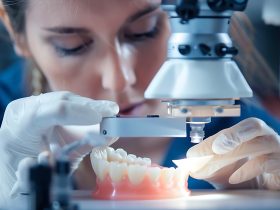When it comes to orthodontic treatment, the decision between traditional braces and Invisalign is a significant one. Both methods offer unique advantages and can effectively straighten teeth, but the right choice depends on various factors including treatment duration, aesthetics, cost, and lifestyle considerations. This guide provides an in-depth comparison to help you make an informed decision.
Treatment Duration
Braces: Traditional braces typically require a longer treatment time, ranging from 18 months to 3 years. However, they work continuously, which can be beneficial for complex cases requiring significant tooth movement.
Invisalign: Invisalign generally offers a shorter treatment duration, with most cases completed within 12 to 18 months. The exact time depends on the patient’s compliance with wearing the aligners for the recommended 20-22 hours per day.
Aesthetics
Braces: Traditional metal braces are more visible, which can be a concern for some patients, especially adults. Ceramic braces offer a less noticeable alternative, but they are still more apparent than Invisalign.
Invisalign: One of the most appealing aspects of Invisalign is its near invisibility. The clear aligners are discreet, making them a popular choice for those who wish to straighten their teeth without drawing attention to their treatment.
Cost
Braces: The cost of traditional braces can vary widely but is generally more affordable than Invisalign. The price includes all visits, adjustments, and, in most cases, post-treatment retainers.
Invisalign: Invisalign tends to be more expensive due to the custom manufacturing of each aligner set. However, many dental insurance plans now cover Invisalign to the same extent as traditional braces, and flexible payment plans are often available.
Lifestyle Considerations
Braces: With braces, patients need to avoid certain hard or sticky foods that can damage the brackets and wires. Oral hygiene can also be more challenging, requiring special tools to clean around braces effectively.
Invisalign: The removability of Invisalign aligners offers significant lifestyle benefits. Patients can eat and drink whatever they like and maintain their usual oral hygiene routine with ease. However, the need to remove the aligners to eat or drink anything other than water and to clean them regularly requires discipline.
Effectiveness
Braces: Traditional braces are highly effective for treating a wide range of orthodontic issues, including more complex cases. They offer orthodontists a high degree of control over tooth movement.
Invisalign: Invisalign is effective for mild to moderate orthodontic issues, including crowding, spacing, and some bite issues. Advances in technology have expanded its capabilities, but there may still be cases where braces are recommended for optimal results.
Comfort
Braces: Braces can cause discomfort, especially after adjustments. The brackets and wires can irritate the inside of the mouth, though orthodontic wax can help.
Invisalign: Many patients find Invisalign more comfortable than braces. The aligners are made from smooth plastic with no sharp edges. However, some discomfort is normal as teeth begin to move.
Suitability
Braces: Almost anyone needing orthodontic treatment can be treated with braces, regardless of the complexity of their case.
Invisalign: Not everyone is a candidate for Invisalign. The treatment is suitable for most adults and teenagers with mild to moderate orthodontic issues, but severe cases may require braces.
Making Your Decision
Choosing between braces and Invisalign involves weighing these factors against your personal needs and preferences. Consider the following steps:
- Consult an Orthodontist: An experienced orthodontist can evaluate your specific case and recommend the best treatment option based on your orthodontic needs.
- Consider Your Lifestyle: Think about how each treatment option fits into your daily life, including any potential impact on your diet, oral hygiene routine, and comfort.
- Evaluate the Aesthetic Impact: Decide how important the visibility of your orthodontic treatment is to you. If discretion is a priority, Invisalign might be the preferable choice.
- Budget Considerations: Compare the costs of both options, taking into account insurance coverage and available payment plans.
- Think Long-Term: Remember that the goal of orthodontic treatment is to achieve a healthy, beautiful smile. Consider which option will best meet your long-term needs.
Both braces and Invisalign have transformed millions of smiles worldwide. By carefully considering these factors and consulting with an orthodontic professional, you can choose the treatment path that aligns with your goals, lifestyle, and budget, setting you on the path to the smile you’ve always wanted.














